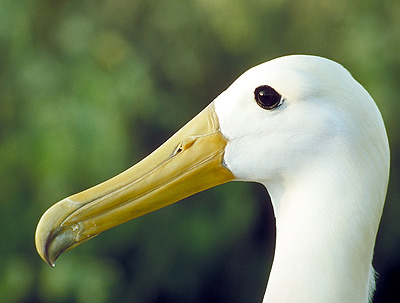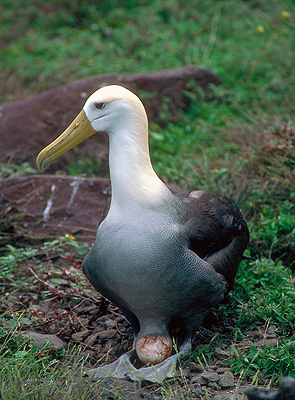The Waved Albatross is the largest of the breeding birds on the Galapagos Islands. While they nest on the islands, the birds fish off the coast of Peru 1000 km (620 mls) to the east, in the area where they live out of the breeding season. It is the only species of albatross found in the tropics.
The name comes from the waved pattern on the feathers found on the adults. These long lived slow reproducing birds are being affected by longline fishing like other species of albatross.
Waved Albatross - Phoebastria irrorata
Profile - Animals of the Galapagos
In the "Rime of the Ancient Mariner" the albatross was the "bird that made the wind to blow" though the species is not identified. All albatrosses are soaring birds with very long narrow wings and a relatively short body. They can struggle to take off from land or from the sea surface, though at sea there is more oftena breexe which they can use to help them get airborne, on land they often nest in places where there is a cliff and a reliable onshore breeze to help them take off.
waved albatross facts - Basics
Weight: 2.7 - 4.0 kg (6 - 8.8 lbs)
Length: 80 - 90 cm (2.6 - 2.9 feet), wingspan 220 - 250 cm (7.2 - 8.2 feet)
Breeding: An elaborate courtship ritual consisting of bill circling and clacking, a waddle dance and vocalizations with an upturned bill leads to a single egg being laid between mid April and late June. Incubation takes around 60 days and the chick is fed by both parents for about 170 days. The long 1,000 km trip to the fishing grounds means that feeds are infrequent (every week or two) but very substantial. The chicks are fed on a predigested oil of fish and squid made by the parents. Waved albatrosses take about 6 years to reach maturity and pair for life.
Estimated world population: Estimated at around 34,000 on the Galapagos with 20-40 on Isla de la Plata 40 km off the coast of Ecuador.
Feeding: Squid, fish and crustaceans, but also items discarded by or stolen from other birds such as boobies.
Conservation status: Critically endangered. The breeding population is confined almost totally to one region of the island of Espanola and has undergone a recent decline in size.
Distribution: Galapagos Islands, Isla de la Plata. East coast of Ecuador and Peru out of the breeding season.
Predators: There are no predators on the adults though many die as a result of longline fishing and also of more traditional fishing practices where the birds are used for food and the feathers sold.
What are Waved Albatrosses Like?

While getting airborne is not always the easiest task for these large soaring birds, once they are up and flying, things become a lot easier. Albatrosses in general rarely flap their wings, instead they use the energy of wind and wave to keep them in flight, flying for an albatross is less about flapping as it is about making small attitudinal changes of their wings, tail and heads to control their attitude and direction. Thus the Waved Albatrosses can fly 1,000 km from the Galapagos Islands to the east coast of South America to go fishing and then fly back again to feed their chicks, using little more energy in the flight than if they had spent the time sitting on the nest.
Top banner credit - Gregory "Greg" Smith used under CC2 Attribution Share alike license.



